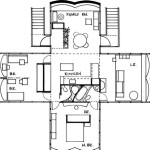The Proper Way to Dimension a Floor Plan
A well-dimensioned floor plan is an indispensable tool for architects, designers, and builders. It provides clear and accurate information about the size and layout of a space, enabling efficient planning, construction, and communication. Mastering the art of dimensioning floor plans ensures clarity, professionalism, and avoids costly errors during the construction process.
1. Essential Dimension Types
Understanding the different types of dimensions is crucial for creating a comprehensive floor plan. There are three primary types:
- Overall Dimensions: These dimensions indicate the overall size of the room or building. They are typically placed outside the walls and show the length and width of the space.
- Wall Dimensions: These dimensions specify the thickness of interior and exterior walls. They are typically placed along the wall lines, showing the distance between the two faces of the wall.
- Room Dimensions: These dimensions provide the usable space within each room. They are placed within the room boundaries, showing the clear distance between the walls, excluding the wall thickness.
Additionally, specific dimensions may be required for elements like windows, doors, fireplaces, and other architectural features. These dimensions should be clearly labelled and placed in a way that doesn't clutter the plan.
2. Dimensioning Standards and Conventions
Maintaining consistency and adhering to industry standards is essential for creating a professional and easily interpretable floor plan. Some key conventions to follow include:
- Dimension Units: Stick to a single unit of measurement throughout the plan, typically feet or meters. Clearly indicate the unit of measurement in the plan's title block or legend.
- Dimension Line Placement: Dimension lines should be parallel to the measured feature and placed outside the line representing the feature. Avoid placing them on top of other lines or symbols.
- Dimension Line Arrows: Arrows should be placed at the ends of the dimension line, pointing towards the measured feature. The arrowheads should be consistent in size and style.
- Dimension Text Placement: Dimension text should be placed above or below the dimension line and aligned with the line. The text should be legible and clearly indicate the dimension value.
- Dimension Line Spacing: Maintain sufficient spacing between dimension lines and other elements on the drawing to prevent clutter. Avoid overlapping lines or text.
Adhering to these conventions ensures consistency and clarity, making the floor plan easy to understand and interpret.
3. Utilizing Dimensioning Techniques
Different dimensioning techniques can be employed to effectively convey information on a floor plan. Here are some commonly used methods:
- Linear Dimensioning: This technique uses dimension lines to indicate the length and width of a space or feature, typically with arrows at either end. It is the most common method for dimensioning walls, rooms, and overall dimensions.
- Radial Dimensioning: Used for circular or curved features, this technique uses dimension lines that radiate from the center point, showing the radius or diameter of the shape.
- Ordinate Dimensioning: This method utilizes a grid system with horizontal and vertical lines to define points on the plan. Dimensions are then placed along these grid lines, referencing the specific points.
- Leader Dimensioning: A leader line connected to a dimension text is used to indicate the position of a specific feature or point on the plan.
The choice of dimensioning technique should be based on the specific requirements of the project and the complexity of the plan.
By understanding the fundamental concepts of dimensioning, adhering to industry standards, and employing effective techniques, architects, designers, and builders can create clear, accurate, and professional floor plans that facilitate efficient planning, communication, and construction.

How To Read A Floor Plan With Dimensions Houseplans Blog Com

How To Properly Read Floor Plans And What Details Look For

Dimensioning Rules For Architectural Floor Plans By Joe Caruso On Prezi Next

Adding Dimensions To Your Floor Plan

How To Read A Floor Plan With Dimensions Houseplans Blog Com

Meaning Of Layout Corner Bar Sketchup Community

12 Examples Of Floor Plans With Dimensions

Floor Plans With Dimensions Including Examples Cedreo

How To Read Floor Plans With Dimensions A Guide
Floor Plans








